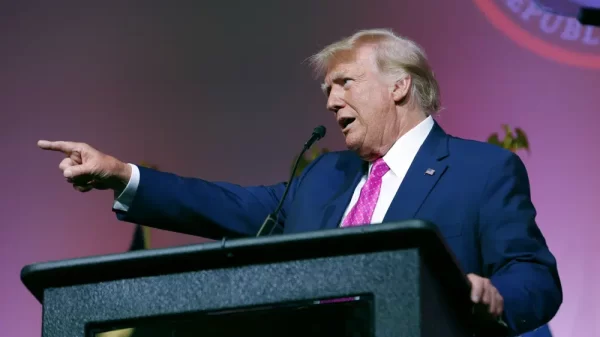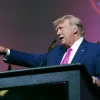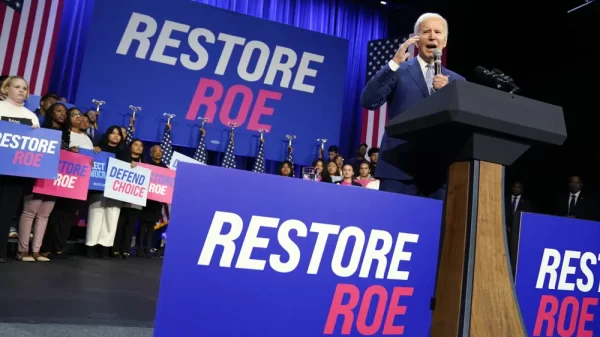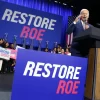FILE – In this Jan. 25, 2021, file photo, President Joe Biden answers questions from reporters in the South Court Auditorium on the White House complex, in Washington. Biden is unlikely to confront China on trade right away because he wants to focus on the coronavirus and the economy, but he does look set to renew pressure over trade and technology grievances that prompted President Donald Trump to hike tariffs on Chinese imports in 2017. (AP Photo/Evan Vucci, File)
BEIJING (AP) — The U.S.-Chinese trade war isn’t going away under President Joe Biden.
Biden won’t confront Beijing right away, economists say, because he wants to focus on the coronavirus and the economy. But he looks set to renew pressure over trade and technology grievances that prompted President Donald Trump to hike tariffs on Chinese imports in 2017.
Negotiators might tone down Trump’s focus on narrowing China’s multibillion-dollar trade surplus with the United States and push harder to open its state-dominated economy, which matters more in the long run, economists say. But no abrupt tariff cuts or other big changes are expected.
“I think Biden will focus more on trying to extract structural reforms,” said Louis Kuijs of Oxford Economics. “It’s going to take some time before we get any shift or explicit announcements.”
Biden is evaluating tariffs on Chinese goods and wants to coordinate future steps with allies, White House spokeswoman Jen Psaki said Monday. She gave no indication of possible changes.
“The president is committed to stopping China’s economic abuses,” Psaki said.
A Chinese foreign ministry spokesman, Zhao Lijian, appealed to Washington to learn from Trump’s “erroneous policies” and adopt a “constructive attitude” but gave no indication of possible changes by Beijing.
“Cooperation is the only correct choice for both sides,” Zhao said Tuesday.
Trump acted on complaints that are shared by Europe and other traders, but Washington has little to show for its bruising war. It brought President Xi Jinping’s government to the bargaining table but roiled global trade, raised consumer prices and wiped out jobs.
The last major development was a year ago, when Beiing promised in the “Phase One” agreement of January 2020 to buy more soybeans and other U.S. exports and stop pressuring companies to hand over technology.
China fell short on those purchases. Amid the coronavirus turmoil, it bought about 55% of what it promised. As for tech policy, some economists say those changes matter but question whether it counts as a win. They say Beijing might have made them anyway to suit its own plans.
China faces more opposition than ever in Washington due to its trade record, territorial disputes with neighbors, crackdown on Hong Kong, reports of abuses against ethnic Muslims and accusations of technology theft and spying.
“The ground has shifted in a significant way,” said Nathan Sheets, a former Treasury undersecretary for international affairs in the Obama administration.
Katherine Tai, Biden’s choice to succeed U.S. Trade Representative Robert Lighthizer, sounded a hawkish note on China in a speech this month.
“We face stiffening competition from a growing and ambitious China,” said Tai. “A China whose economy is directed by central planners who are not subject to the pressures of political pluralism, democratic elections or popular opinion.’’
That means China has to make changes if wants to make progress, said Raoul Leering, global trade analyst for ING. He said that while many of Trump’s statements were “close to nonsense,” he was right that China has more trade barriers and official intervention in the economy than the United States.
“It will depend on China, the speed at which they reform and change policies, to see whether Biden will roll back trade barriers,” he said.
After 2 1/2 years and 13 rounds of talks, negotiators have yet to tackle one of the biggest irritants for China’s trading partners — the status of politically favored state companies that dominate industries from banking to oil to telecoms.
Europe, Japan and other governments criticized Trump’s tactics but echo complaints that Beijing steals technology and breaks market-opening promises by subsidizing and shielding companies from competition.
Those complaints strike at the heart of a state-led development model Communist Party leaders see as the basis of China’s success.
They are building up “national champions” including PetroChina Ltd., Asia’s biggest oil producer, and China Mobile Ltd., the world’s biggest phone carrier by subscribers. The party in 2013 declared state industry the “core of the economy.”
Outside the state sector, the party is nurturing competitors in solar power, electric cars, next-generation telecoms and other fields.
Beijing could offer to drop its claim to being a developing economy, a status it insists on despite having become one of the biggest manufacturers and a middle-income society, Leering said. Under WTO rules, that allows the Communist Party to protect industries and intervene more in the economy.
Giving that up “would be a very important gesture,” Leering said.
Trump’s opening shot in 2017 was a tax hike on $360 billion worth of Chinese imports. Beijing retaliated with tariff hikes and suspended soybean imports, hitting farm states that voted for Trump in 2016.
The U.S. trade deficit with China narrowed by by 19% in 2019 over a year earlier and by 15% in the first nine months of 2020.
That failed to achieve Trump’s goal of moving jobs to the United States. Importers shifted instead to Taiwan, Mexico and other suppliers. The total U.S. trade deficit dipped slightly in 2019, then rose nearly 14% through November last year.
Meanwhile, the Congressional Budget Office estimates tariff hikes cost the average U.S. household nearly $1,300 last year. Businesses postponed investments, undoing some of the benefits of Trump’s 2017 corporate tax cut.
A study by the U.S.-China Business Council and Oxford Economics found the U.S. economy lost 245,000 jobs due to the tariffs. It said even a modest reduction would create 145,000 jobs by 2025.
Trump stepped up pressure by cutting off access to U.S. technology for telecom equipment giant Huawei Technologies Ltd. and other companies seen by American officials as possible security risks and a threat to U.S. industrial leadership. Americans were ordered to sell shares in Chinese companies Washington says have links to the military.
The Communist Party responded by vowing to accelerate its two-decade-old campaign to make China a self-reliant “technology power.”
Psaki, the White House spokeswoman, said Biden also was reviewing those issues but gave no indication of possible changes.
Biden wants to hold Beijing accountable for “unfair and illegal practices” and make sure American technology doesn’t facilitate its military buildup, Psaki said.
Zhao, the Chinese spokesman, called on Washington not to “politicize or weaponize” science and technology and to avoid “groundless accusations to smear China.”
Biden’s envoys have the option of fine-tuning Trump’s penalties by dropping some in exchange for Chinese policy changes, said Kuijs. But he and other economists say rolling back tariffs and curbs on access to technology and financial markets is unlikely to be a priority.
“It is difficult to see a U.S. reversal of the recent hawkish trends in China policy,” Sylvia Sheng of JP Morgan Asset Management said in a report.
Tech curbs are unlikely to be eased because Washington “regards China as a competitor,” said Tu Xinquan, director of the Institute for WTO Studies at the University of International Business and Economics in Beijing.
Tariff cuts look like the only short-term option, Tu said. He said Biden could defend getting rid of taxes the World Trade Organization says were improperly imposed.
“In that case, he wouldn’t lose face,” said Tu.
___
AP researcher Yu Bing in Beijing contributed.
___
Wiseman reported from Washington.
Copyright 2020 Associated Press. All rights reserved.





























